- ACTIVITIES
85 Iconic Movie Quotes Trivia Questions to Test Your Film Knowledge


Pesto, a vibrant and aromatic sauce, has long been a staple in Italian cuisine, celebrated for its versatility and rich flavor. Whether drizzled over pasta, used as a sandwich spread, or incorporated into a marinade, its applications are endless. Mastering how to make pesto at home not only ensures freshness but also allows for creative variations to suit your palate. This guide will walk you through the essentials of crafting the perfect pesto, from classic recipes to inventive alternatives, while also covering storage, freezing, and reheating techniques to maintain its delightful taste.
Pesto’s flavor is a harmonious blend of fresh basil, garlic, pine nuts, Parmesan cheese, and olive oil. This combination creates a creamy texture with a nutty, herbaceous taste that complements a variety of dishes. Traditionally paired with pasta, pesto also enhances the flavor of grilled meats, vegetables, and even scrambled eggs. Its versatility makes it a must-have in any culinary repertoire.
To make pesto, you’ll need a few key tools to ensure the best results. A high-quality food processor or blender is essential for achieving the smooth, consistent texture that defines a good pesto. Additionally, a sharp chef’s knife and cutting board are necessary for prepping ingredients, while a microplane grater will help you finely grate the cheese. Lastly, a spatula is useful for scraping down the sides of the processor to ensure all ingredients are well combined.

The classic basil pesto recipe is a timeless favorite, perfect for those new to pesto making or seasoned cooks seeking a reliable staple.
Pesto’s adaptability allows for numerous ingredient substitutions, catering to different tastes and dietary needs.
Proper storage is crucial to preserving pesto’s vibrant color and flavor. Freshly made pesto should be stored in an airtight container in the refrigerator. To prevent oxidation, cover the surface with a thin layer of olive oil or plastic wrap directly touching the pesto. This method keeps the pesto fresh for up to a week.
Freezing is an excellent way to extend the life of homemade pesto. For best results, spoon the pesto into ice cube trays or silicone molds and freeze until solid. Once frozen, transfer the pesto cubes to a freezer-safe bag or container, removing as much air as possible to prevent freezer burn. Pesto can be frozen for up to six months without significant loss of flavor.
When reheating pesto, it’s essential to preserve its delicate flavors. Avoid microwaving, as this can alter the texture and taste. Instead, allow frozen pesto to thaw in the refrigerator overnight. Once thawed, gently warm the pesto in a saucepan over low heat, stirring frequently. If the pesto appears too thick, add a splash of olive oil or a tablespoon of pasta cooking water to achieve the desired consistency.
Even seasoned cooks can encounter pitfalls when making pesto. One common mistake is using old or dried basil, which can result in a bitter taste. Always opt for fresh, vibrant leaves. Additionally, over-processing the ingredients can lead to a pasty texture; pulse just enough to combine. Lastly, avoid overheating the pesto during reheating, as this can diminish its fresh flavor.
Whether due to dietary restrictions or personal preference, substitutions can be made for most pesto ingredients. For a dairy-free option, replace Parmesan cheese with nutritional yeast or a vegan cheese alternative. If pine nuts are unavailable or costly, try using almonds, cashews, or sunflower seeds. Each substitution brings a unique flavor profile to the pesto, allowing for endless experimentation.
Beyond the classic basil pesto, the world of pesto offers a variety of exciting flavors. Consider experimenting with arugula, kale, or cilantro as the base herb. For a twist, incorporate roasted red peppers or artichokes. Each variation provides a new taste experience, perfect for adventurous home cooks looking to expand their culinary horizons.
Olive oil is a fundamental component of pesto, providing a rich, smooth texture and enhancing the overall flavor. Its quality can significantly impact the taste of the finished product. Extra-virgin olive oil is recommended for its robust flavor and health benefits. When incorporating olive oil into pesto, add it slowly to emulsify the mixture, ensuring a creamy consistency.
While fresh basil is the traditional choice for pesto, dried herbs can be used in a pinch. However, the flavor will differ significantly, lacking the vibrant, aromatic quality of fresh basil. If using dried herbs, reduce the quantity to about one-third, as dried herbs are more concentrated. To compensate for the loss of freshness, consider adding a splash of lemon juice or zest.
Pine nuts are the classic choice for pesto, offering a buttery texture and subtle flavor. However, they can be expensive and occasionally hard to find. Walnuts, almonds, and cashews are excellent alternatives, each contributing a distinct taste. Toasting the nuts before use can enhance their flavor and add depth to the pesto.
Lemon juice and cheese are pivotal in balancing pesto’s flavors. A squeeze of lemon juice adds brightness and acidity, cutting through the richness of the nuts and cheese. Parmesan is the traditional cheese used, but Pecorino Romano or Grana Padano can be substituted for a sharper taste. Adjust these elements to suit your personal preference, ensuring a well-rounded and flavorful pesto.